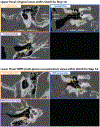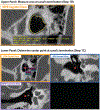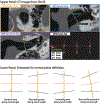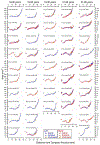Measurements of ear-canal geometry from high-resolution CT scans of human adult ears
- PMID: 37201272
- PMCID: PMC10219681
- DOI: 10.1016/j.heares.2023.108782
Measurements of ear-canal geometry from high-resolution CT scans of human adult ears
Abstract
Description of the ear canal's geometry is essential for describing peripheral sound flow, yet physical measurements of the canal's geometry are lacking and recent measurements suggest that older-adult-canal areas are systematically larger than previously assumed. Methods to measure ear-canal geometry from multi-planar reconstructions of high-resolution CT images were developed and applied to 66 ears from 47 subjects, ages 18-90 years. The canal's termination, central axis, entrance, and first bend were identified based on objective definitions, and the canal's cross-sectional area was measured along its canal's central axis in 1-2 mm increments. In general, left and right ears from a given subject were far more similar than measurements across subjects, where areas varied by factors of 2-3 at many locations. The canal areas varied systematically with age cohort at the first-bend location, where canal-based measurement probes likely sit; young adults (18-30 years) had an average area of 44mm2 whereas older adults (61-90 years) had a significantly larger average area of 69mm2. Across all subjects ages 18-90, measured means ± standard deviations included: canals termination area at the tympanic annulus 56±8mm2; area at the canal's first bend 53±18mm2; area at the canal's entrance 97±24mm2; and canal length 31.4±3.1mm2.
Keywords: Age related ear canal areas; CT Scan ear canal; Ear canal anatomy.
Copyright © 2023 Elsevier B.V. All rights reserved.
Figures













References
-
- Balouch A, 2021. Describing the geometry of the ear canal from CT scans. Undergraduate thesis, Smith College, Northampton, MA. URL https://scholarworks.smith.edu/theses/2316/
-
- Bland JM, Altman DG, 1986. Statistical methods for assessing agreement between two methods of clinical measurement. The Lancet, 307–310. - PubMed
-
- Egolf DP, Nelson DK, Howell HC, Larson VD, May 1993. Quantifying ear-canal geometry with multiple computer-assisted tomographic scans. J. Acoust. Soc. Am 93 (5), 2809–2819. - PubMed
-
- Farmer-Fedor BL, Rabbitt RD, 2002. Acoustic intensity, impedance and reflection coefficient in the human ear canal. J. Acoust. Soc. Am 112, 600620. - PubMed
-
- Feeney MP, 2013. Eriksholm workshop: Wideband absorbance measures of the middle ear. Ear Hear 34, Supplement 1. - PubMed
Publication types
MeSH terms
Grants and funding
LinkOut - more resources
Full Text Sources
Other Literature Sources

